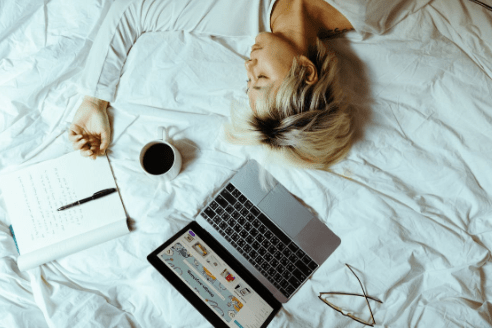Most of us are exposed to blue light every day, whether it’s from the sun, our computers, or our phones. While blue light is essential for keeping us alert and helping us to see during the daytime, too much exposure can be harmful.
Excessive blue light exposure has been linked to a number of health issues, including eye strain, headaches, and even insomnia. If you’re looking for ways to reduce your exposure to blue light, here are six helpful tips.
1. Use protective eyewear
Wearing protective eyewear is one of the best ways to reduce your exposure to blue light. These blue light blockers can help reduce eye strain and prevent other damage from excessive exposure to blue light. There are a number of different types of glasses and lenses that can help to filter out blue light, including computer glasses and blue-light-blocking contact lenses.
If you wear contact lenses, be sure to ask your doctor about blue-light-blocking options. And if you’re looking for a pair of computer glasses, look for ones that have a special coating that helps to filter out blue light.
2. Use the 20-20-20 rule
The 20-20-20 rule is a simple but effective way to reduce eye fatigue and strain caused by extended periods of looking at screens. The rule is simply this: every 20 minutes, take a 20-second break to look at something at least 20 feet away. This gives your eyes a much-needed break from the close-up work of staring at a computer screen and also allows them to refocus on distant objects, which helps reduce eye strain.
The 20-20-20 rule is a great way to give your eyes and overall health a little boost with very minimal effort or inconvenience. In fact, it’s such an essential tip that many employers are now encouraging their employees to make use of this technique in order to increase productivity while also reducing the incidence of repetitive strain injuries and other musculoskeletal issues. And since you can easily practice this tip either by using a timer or an app, there really is no downside! So why not start implementing the 20-20-20 rule today and start enjoying its benefits?
3. Install a blue-light filter app on your phone or tablet
Similar to protective eyewear, many mobile devices now come with built-in features that can help minimize blue light emissions. You can also install third-party apps like Twilight or Blue Light Filter to further customize your device’s settings and reduce the amount of blue light you’re exposed to. You could also adjust your device’s display settings to reduce the amount of blue light emitted from the screen. Lots of people facing blue light exposure issues are looking for iPad screen repair services that will keep their phones, computers, and tablets working in a way they don’t put such a strain on their eyes. This is done by reducing the amount of blue light coming from your device. For example, you can increase the font size on your phone or tablet and reduce the amount of time you spend staring at a screen.
4. Choose a comfortable place to work
The environment where you do your work can have a major impact on the strain and fatigue your eyes experience when working at a computer, so it’s important that you choose one that’s both comfortable and appropriate for the task at hand. For example, if possible, try to find a desk or other surface where you can comfortably rest your forearms (this helps reduce tension in the shoulders). And since bright rooms are more likely to cause eye strain than darker ones, consider working in an area with blinds or curtains drawn – especially if the sun’s rays tend to stream indirectly.
5. Adjust the settings on your computer
If you find yourself experiencing eye strain or fatigue while working at a computer, it’s important to take a look at the settings on your machine to see if there are any adjustments you can make. For example, did you know that the brightness of your screen can actually have an impact on how much strain your eyes experience? If the answer is no, don’t worry – you’re not alone. In fact, many people don’t realize that the brightness of their screens is often set too high by default, which can cause a significant amount of eye strain over time.
Fortunately, adjusting the brightness of your screen is a relatively simple task that only takes a few seconds to do. On a Windows PC, you can usually find the setting by clicking on the “Start” button and then navigating to “Control Panel -> Appearance and Personalization -> Adjust Screen Brightness.” For Mac users, the setting is usually located under “System Preferences -> Displays -> Adjust Brightness.” Once you’ve located the setting, simply drag the slider until the screen is set to a brightness level that’s comfortable for your eyes.
6. Limit your exposure to blue light
One of the most harmful types of light for your eyes is blue light, which is emitted by digital screens such as computers, phones, and tablets. While exposure to blue light during the daytime can actually have some benefits (such as improved alertness), too much exposure at night can cause a number of problems including difficulty sleeping and eye strain. So if you want to reduce your risk of experiencing these problems, it’s important to limit your exposure to blue light in the evening hours.
By following these simple tips, you can minimize your exposure to blue light and keep your eyes and body healthy. With a little extra effort, you can enjoy all the benefits of modern technology while minimizing the risks associated with excessive exposure to blue light.


